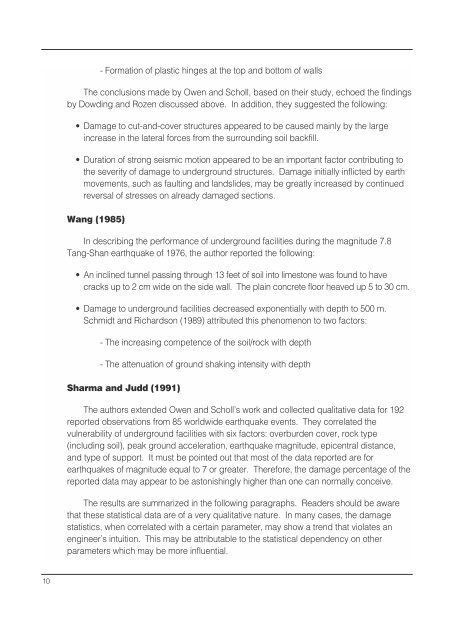Seismic Design of Tunnels - Parsons Brinckerhoff
Seismic Design of Tunnels - Parsons Brinckerhoff
Seismic Design of Tunnels - Parsons Brinckerhoff
You also want an ePaper? Increase the reach of your titles
YUMPU automatically turns print PDFs into web optimized ePapers that Google loves.
- Formation <strong>of</strong> plastic hinges at the top and bottom <strong>of</strong> walls<br />
The conclusions made by Owen and Scholl, based on their study, echoed the findings<br />
by Dowding and Rozen discussed above. In addition, they suggested the following:<br />
• Damage to cut-and-cover structures appeared to be caused mainly by the large<br />
increase in the lateral forces from the surrounding soil backfill.<br />
• Duration <strong>of</strong> strong seismic motion appeared to be an important factor contributing to<br />
the severity <strong>of</strong> damage to underground structures. Damage initially inflicted by earth<br />
movements, such as faulting and landslides, may be greatly increased by continued<br />
reversal <strong>of</strong> stresses on already damaged sections.<br />
Wang (1985)<br />
In describing the performance <strong>of</strong> underground facilities during the magnitude 7.8<br />
Tang-Shan earthquake <strong>of</strong> 1976, the author reported the following:<br />
• An inclined tunnel passing through 13 feet <strong>of</strong> soil into limestone was found to have<br />
cracks up to 2 cm wide on the side wall. The plain concrete floor heaved up 5 to 30 cm.<br />
• Damage to underground facilities decreased exponentially with depth to 500 m.<br />
Schmidt and Richardson (1989) attributed this phenomenon to two factors:<br />
- The increasing competence <strong>of</strong> the soil/rock with depth<br />
- The attenuation <strong>of</strong> ground shaking intensity with depth<br />
Sharma and Judd (1991)<br />
The authors extended Owen and Scholl’s work and collected qualitative data for 192<br />
reported observations from 85 worldwide earthquake events. They correlated the<br />
vulnerability <strong>of</strong> underground facilities with six factors: overburden cover, rock type<br />
(including soil), peak ground acceleration, earthquake magnitude, epicentral distance,<br />
and type <strong>of</strong> support. It must be pointed out that most <strong>of</strong> the data reported are for<br />
earthquakes <strong>of</strong> magnitude equal to 7 or greater. Therefore, the damage percentage <strong>of</strong> the<br />
reported data may appear to be astonishingly higher than one can normally conceive.<br />
The results are summarized in the following paragraphs. Readers should be aware<br />
that these statistical data are <strong>of</strong> a very qualitative nature. In many cases, the damage<br />
statistics, when correlated with a certain parameter, may show a trend that violates an<br />
engineer’s intuition. This may be attributable to the statistical dependency on other<br />
parameters which may be more influential.<br />
10
















